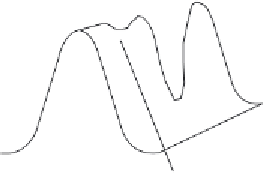Image Processing Reference
In-Depth Information
threshold is reached. The arrows reflect possible movement: there is only one way to
change from black to white and vice versa.
Thresholded data
White
Black
Brightness
Upper switching threshold
Lower switching threshold
Figure 4.17
Hysteresis thresholding transfer function
The application of non-maximum suppression and hysteresis thresholding is illustrated
in Figure
4.18
. This contains a ridge of edge data, the edge magnitude. The action of non-
maximum suppression is to select the points along the top of the ridge. Given that the top
of the ridge initially exceeds the upper threshold, the thresholded output is set to white
until the peak of the ridge falls beneath the lower threshold. The thresholded output is then
set to black until the peak of the ridge exceeds the upper switching threshold.
Hysteresis thresholded edge data
Upper switching threshold
Lower switching threshold
Non-maximum suppression
Figure 4.18
Action of non-maximum suppression and hysteresis thresholding
Hysteresis thresholding requires two thresholds, an
upper
and a
lower
threshold. The
process starts when an edge point from non-maximum suppression is found to exceed the
upper threshold. This is labelled as an edge point (usually white, with a value 255) and
































